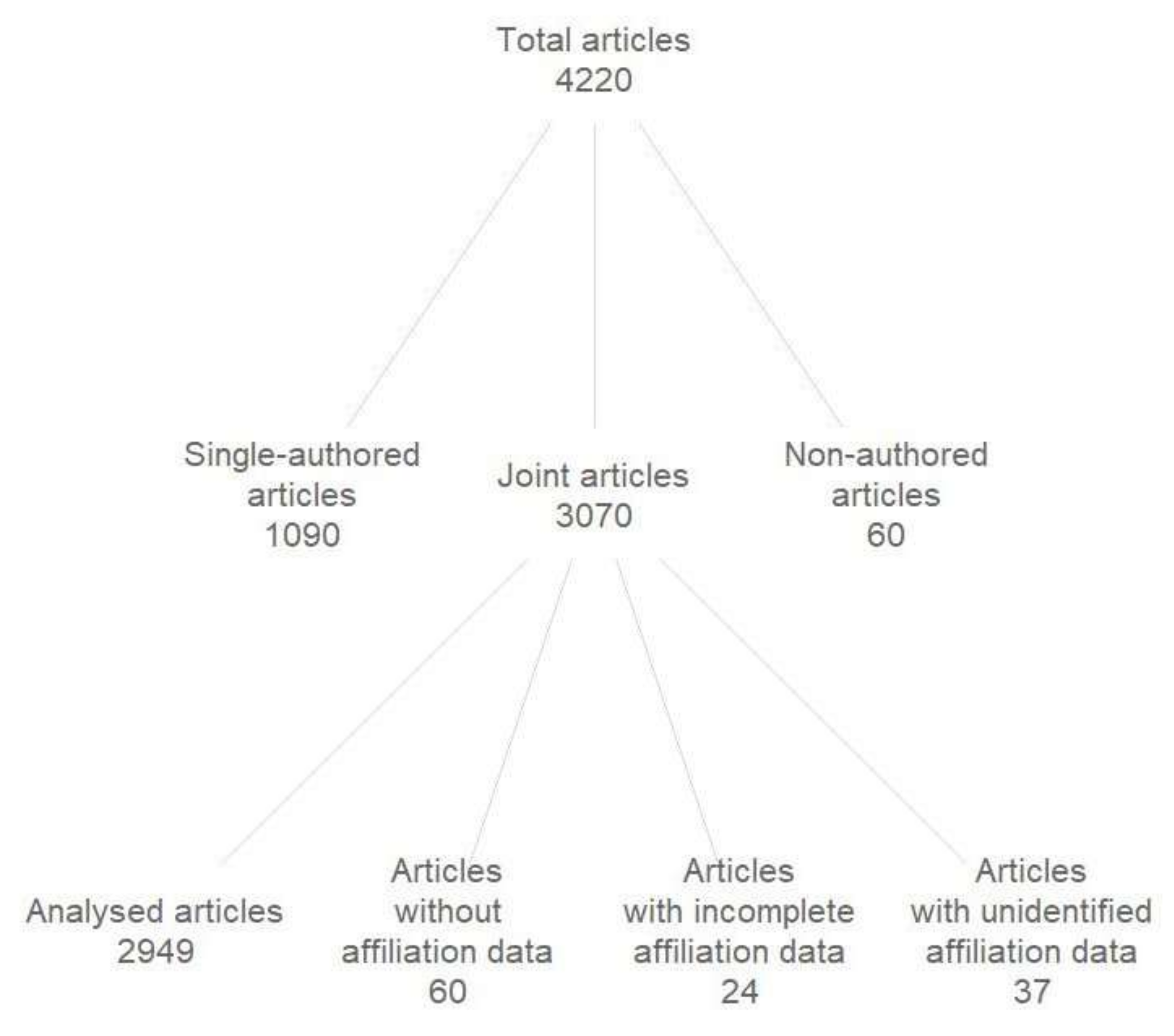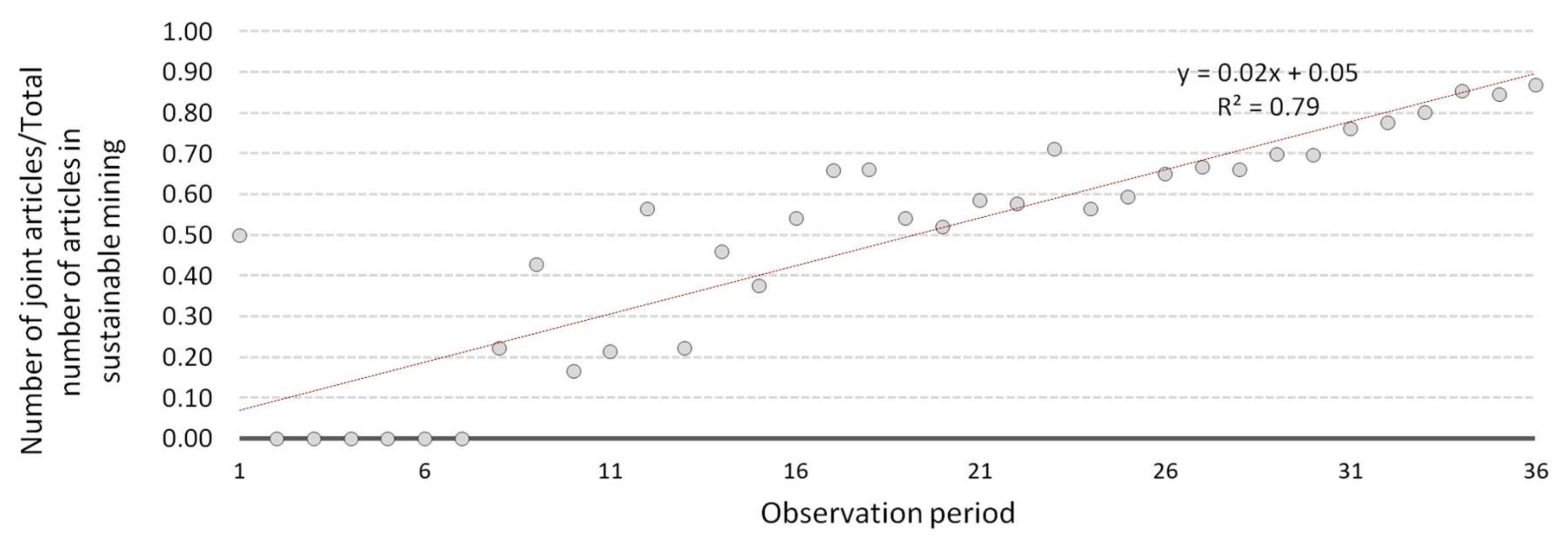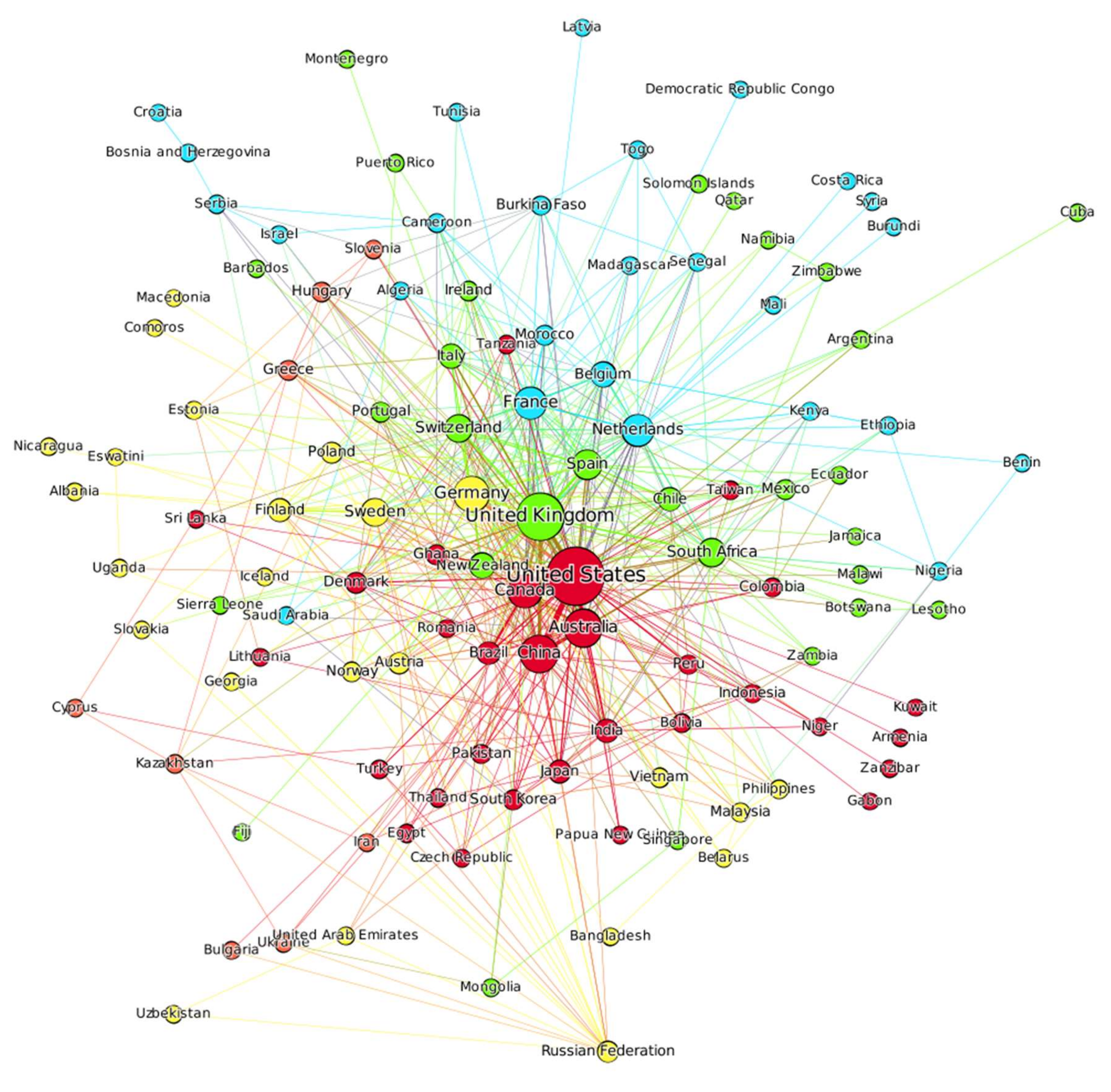Research Collaboration Patterns in Sustainable Mining—A Co-Authorship Analysis of Publications
Abstract
1. Introduction
- What are the trends in the relative numbers of joint articles and the types of joint articles (interinstitutional, international and cross-sector) over the studied period?
- What are the team sizes in terms of the number of authors, institutions, countries and sectors engaged in publication activities?
- What is the nature of networks of collaborators on different aggregation levels (countries, institution types, institutions)? Do the phenomena of cooperation in this study form sparse networks or rather dense ones? Is this density distributed equally? What are the most frequently cooperating hubs of entities?
2. Materials and Methods
2.1. Investigation of Research Collaboration Based on the Co-Authorship—Theoretical Background
2.2. Data Source and Search Query
2.3. Data Acquisition, Cleaning and Preparation
2.4. Trend and Network Analysis
3. Results
3.1. Trend Analysis
3.2. Network Analysis
- The Chinese Academy of Sciences (China),
- The University of Queensland (Australia),
- The University of California (The United States),
- Commonwealth Scientific and Industrial Research Organization—CSIRO (Australia),
- The United States Department of the Interior, Washington DC (The United States).
- The two most cooperating institution pairs were:
- CSIRO (Australia)—The University of Queensland (Australia),
- AGH University of Science and Technology (Poland)—the Polish Academy of Sciences (Poland).
- The United States—China,
- The United States—The United Kingdom,
- Australia—China,
- The United Kingdom—China,
- The United States—Australia,
- The United States—Canada.
4. Discussion and Conclusions
Supplementary Materials
Author Contributions
Funding
Conflicts of Interest
References
- De Mesquita, R.F.; Xavier, A.; Klein, B.; Matos, F.R.N. Mining and the Sustainable Development Goals: A Systematic Literature Review. Geo-Resour. Environ. Eng. GREE 2017, 2, 29–34. [Google Scholar] [CrossRef][Green Version]
- WCED. Our Common Future; University Press: Oxford, UK, 1987; Available online: https://sustainabledevelopment.un.org/content/documents/5987our-common-future.pdf (accessed on 27 April 2020).
- Allan, R. Introduction: Sustainable Mining in the Future. J. Geochem. Explor. 1995, 52, 1–4. [Google Scholar] [CrossRef]
- Dubiński, J. Sustainable Development of Mining Mineral Resources. J. Sustain. Min. 2013, 12, 1–6. [Google Scholar] [CrossRef]
- Hendrix, J.L. Sustainable Mining: Trends and Opportunities. J. Benef. Phosphates Technol. Sustain. 2006, 51–60. [Google Scholar] [CrossRef]
- Porter, M.; Franks, D.M.; Everingham, J.A. Cultivating Collaboration: Lessons from Initiatives to Understand and Manage Cumulative Impacts in Australian Resource Regions. Resour. Policy 2013, 38, 657–669. [Google Scholar] [CrossRef]
- McDonald, S.; Young, S. Cross-Sector Collaboration Shaping Corporate Social Responsibility Best Practice within the Mining Industry. J. Clean. Prod. 2012, 37, 54–67. [Google Scholar] [CrossRef]
- Esteves, A.M.; Barclay, M.A. New Approaches to Evaluating the Performance of Corporate-Community Partnerships: A Case Study from the Minerals Sector. J. Bus. Ethics 2011, 103, 189–202. [Google Scholar] [CrossRef]
- Bullock, R.; Kirchhoff, D.; Mauro, I.; Boerchers, M. Indigenous Capacity for Collaboration in Canada’s Energy, Forestry and Mining Sectors: Research Metrics and Trends. Environ. Dev. Sustain. 2018, 20, 883–895. [Google Scholar] [CrossRef]
- Miyoshi, M.E. University and Industry Collaboration in Canadian Mining Education. Master Thesis’s, The University of British Columbia, Vancouver, BC, Canada, 2015. Available online: https://open.library.ubc.ca/cIRcle/collections/ubctheses/24/items/1.0167111 (accessed on 27 April 2020).
- Laudel, G. Collaboration, Creativity and Rewards: Why and How Scientists Collaborate. Int. J. Technol. Manag. 2001, 22, 762–781. [Google Scholar] [CrossRef]
- Beaver, D.D. Does Collaborative Research Have Greater Epistemic Authority? Scientometrics 2004, 60, 399–408. [Google Scholar] [CrossRef]
- Beaver, D.D. Reflections on Scientific Collaboration (and Its Study): Past, Present, and Future. Scientometrics 2001, 52, 365–377. [Google Scholar] [CrossRef]
- Scarano, F.R. The Emergence of Sustainability. In Emergence and Modularity in Life Sciences; Wegner, L.H., Lüttge, U., Eds.; Springer Nature: Basel, Switzerland, 2019; pp. 51–71. Available online: https://www.springer.com/gp/book/9783030061272 (accessed on 27 April 2020).
- McCullough, C.D. Mine Water Research: Enhancing Mining Industry and Academic Collaboration. Mine Water Environ. 2015, 35, 113–118. [Google Scholar] [CrossRef]
- Aznar-Sánchez, J.; García-Gómez, J.; Velasco-Muñoz, J.; Carretero-Gómez, A. Mining Waste and Its Sustainable Management: Advances in Worldwide Research. Minerals 2018, 8, 284. [Google Scholar] [CrossRef]
- English, L.M.; Wang, Y.J. Mining Research Trends as Reflected in SME Transactions, 1961-1990. Min. Eng. 1995, 47, 927–931. [Google Scholar]
- Frame, J.D.; Baum, J.J.; Card, M. An Information Approach to Examining Developments in an Energy Technology: Coal Gasification. J. Am. Soc. Inf. Sci. 1979, 30, 193–201. [Google Scholar] [CrossRef]
- De Solla Price, D.J. Little Science, Big Science; Columbia University Press: New York, NY, USA, 1963. [Google Scholar]
- Ponomariov, B.; Boardman, C. What Is Co-Authorship? Scientometrics 2016, 109, 1939–1963. [Google Scholar] [CrossRef]
- ICMJE. Defining the Role of Authors and Contributors. Available online: http://www.icmje.org/recommendations/browse/roles-and-responsibilities/defining-the-role-of-authors-and-contributors.html (accessed on 27 April 2020).
- Wagner, C.S.; Park, H.W.; Leydesdorff, L. The Continuing Growth of Global Cooperation Networks in Research: A Conundrum for National Governments. PLoS ONE 2015, 10, e0131816. [Google Scholar] [CrossRef] [PubMed]
- Cainelli, G.; Maggioni, M.A.; Uberti, T.E.; De Felice, A. The Strength of Strong Ties: How Co-Authorship Affect Productivity of Academic Economists? Scientometrics 2015, 102, 673–699. [Google Scholar] [CrossRef]
- Katz, J.S.; Martin, B.R. What Is Research Collaboration? Res. Policy 1997, 26, 1–18. [Google Scholar] [CrossRef]
- Lundberg, J.; Tomson, G.; Lundkwist, I.; Skar, J.; Brommels, M. Collaboration Uncovered: Exploring the Adequacy of Measuring University-Industry Collaboration through Co-Authorship and Funding. Scientometrics 2006, 69, 575–589. [Google Scholar] [CrossRef]
- Melin, G.; Persson, O. Studying Research Collaboration Using Co-Authorships. Scientometrics 1996, 36, 363–377. [Google Scholar] [CrossRef]
- Mongeon, P.; Paul-Hus, A. The Journal Coverage of Web of Science and Scopus: A Comparative Analysis. Scientometrics 2016, 106, 213–228. [Google Scholar] [CrossRef]
- Glänzel, W.; Schubert, A. Analysing Scientific Networks through Co-Authorship. In Handbook of Quantitative Science and Technology Research; Moed, H.F., Glänzel, W., Schmoch, U., Eds.; Springer: Dordrecht, The Netherland, 2004; pp. 257–276. [Google Scholar] [CrossRef]
- Glänzel, W. National Characteristics in International Scientific Co-Authorship Relations. Scientometrics 2001, 51, 69–115. [Google Scholar] [CrossRef]
- Uzun, A. Assessing Internationality of Scholarly Journals through Foreign Authorship Patterns: The Case of Major Journals in Information Science, and Scientometrics. Scientometrics 2004, 61, 457–465. [Google Scholar] [CrossRef]
- Calver, M.; Wardell-Johnson, G.; Bradley, S.; Taplin, R. What Makes a Journal International? A Case Study Using Conservation Biology Journals. Scientometrics 2010, 85, 387–400. [Google Scholar] [CrossRef]
- Morrison, F.A. Obtaining Uncertainty Measures on Slope and Intercept of a Least Squares Fit with Excel’s LINEST. Available online: http://facstaff.cbu.edu/~jvarrian/452/UncertaintySlopeInterceptOfLeastSquaresFit.pdf (accessed on 27 April 2020).
- Bastian, M.; Heymann, S.; Jacomy, M. Gephi: An Open Source Software for Exploring and Manipulating Networks. In ICWSM. Proceedings of the third International AAAI Conference on Weblogs and Social Media, San Jose CA, USA, 17–20 May 2009; AAAI Press: Menlo Park, CA, USA, 2009; pp. 361–362. [Google Scholar] [CrossRef]
- Van Eck, N.J.; Waltman, L. VOS: A New Method for Visualizing Similarities between Objects. In Advances in Data Analysis: Proceedings of the 30th Annual Conference of the German Classification Society; Lenz, H.-J., Decker, R., Eds.; Springer: Berlin/Heidelberg, Germany, 2007; pp. 299–306. [Google Scholar]
- Blondel, V.D.; Guillaume, J.L.; Lambiotte, R.; Lefebvre, E. Fast Unfolding of Communities in Large Networks. J. Stat. Mech. Theory Exp. 2008, 2008, P10008. [Google Scholar] [CrossRef]
- Kamińska, A.M. The Application of Methods of Social Network Analysis in Bibliometrics and Webometrics. Measures and Tools. Nowa Bibl. 2018, 29, 29–46. [Google Scholar]
- Larivière, V.; Gingras, Y.; Sugimoto, C.R.; Tsou, A. Team Size Matters: Collaboration and Scientific Impact since 1900. J. Assoc. Inf. Sci. Technol. 2015, 66, 1323–1332. [Google Scholar] [CrossRef]
- Henriksen, D. The Rise in Co-Authorship in the Social Sciences (1980–2013). Scientometrics 2016, 107, 455–476. [Google Scholar] [CrossRef]
- Wuchty, S.; Jones, B.F.; Uzzi, B. The Increasing Dominance of Teams in Production of Knowledge. Science 2007, 316, 1036–1039. [Google Scholar] [CrossRef] [PubMed]
- Kuld, L.; O’Hagan, J. Rise of Multi-Authored Papers in Economics: Demise of the ‘Lone Star’ and Why? Scientometrics 2017, 114, 1207–1225. [Google Scholar] [CrossRef]
- Sánchez-Jiménez, R.; Guerrero-Bote, V.P.; Moya-Anegón, F. The Role of Guarantor in Scientific Collaboration: The Neighbourhood Matters. J. Informetr. 2017, 11, 103–116. [Google Scholar] [CrossRef]
- Wagner, C.S.; Whetsell, T.A.; Leydesdorff, L. Growth of International Collaboration in Science: Revisiting Six Specialties. Scientometrics 2017, 110, 1633–1652. [Google Scholar] [CrossRef]
- Li, Y.; Li, H.; Liu, N.; Liu, X. Important Institutions of Interinstitutional Scientific Collaboration Networks in Materials Science. Scientometrics 2018, 117, 85–103. [Google Scholar] [CrossRef]
- Yarime, M.; Takeda, Y.; Kajikawa, Y. Towards Institutional Analysis of Sustainability Science: A Quantitative Examination of the Patterns of Research Collaboration. Sustain. Sci. 2009, 5, 115. [Google Scholar] [CrossRef]
- Quental, N.; Lourenço, J.M. References, Authors, Journals and Scientific Disciplines Underlying the Sustainable Development Literature: A Citation Analysis. Scientometrics 2012, 90, 361–381. [Google Scholar] [CrossRef]
- Schoolman, E.D.; Guest, J.S.; Bush, K.F.; Bell, A.R. How Interdisciplinary Is Sustainability Research? Analyzing the Structure of an Emerging Scientific Field. Sustain. Sci. 2012, 7, 67–80. [Google Scholar] [CrossRef]
- Mcdowell, J.M.; Melvin, M. The determinants of co-authorship: An analysis of the economics literature. Rev. Econ. Stat. 1983, 65, 155–160. [Google Scholar] [CrossRef]
- Sonnenwald, D.H. Scientific Collaboration. Annu. Rev. Inf. Sci. Technol. 2007, 41, 643–681. [Google Scholar] [CrossRef]








| Analyzed Articles | Number of Articles |
|---|---|
| Interindividual collaboration (collection of N = 3070 articles) | |
| Joint articles: | 3070 |
| 2 authors | 921 |
| 3 authors | 752 |
| 4–5 authors | 904 |
| 6–10 authors | 444 |
| 11–20 authors | 44 |
| ≥ 21 authors | 5 |
| Inter -institutional, -national and cross-sector collaboration (collection of N = 2949 articles) | |
| Single institution articles | 1375 |
| Interinstitutional articles: | 1574 |
| 1 institution | 1376 |
| 2 institutions | 1023 |
| 3 institutions | 365 |
| 4–5 institutions | 141 |
| 6–10 institutions | 40 |
| ≥ 11 institutions | 4 |
| Single country articles | 2287 |
| International articles: | 662 |
| 1 country | 2287 |
| 2 countries | 531 |
| 3 countries | 90 |
| 4–5 countries | 33 |
| ≥ 6 countries | 8 |
| One sector articles | 2350 |
| Cross-sector articles | 599 |
© 2020 by the authors. Licensee MDPI, Basel, Switzerland. This article is an open access article distributed under the terms and conditions of the Creative Commons Attribution (CC BY) license (http://creativecommons.org/licenses/by/4.0/).
Share and Cite
Bemke-Świtilnik, M.; Drabek, A.; Kamińska, A.M.; Smoliński, A. Research Collaboration Patterns in Sustainable Mining—A Co-Authorship Analysis of Publications. Sustainability 2020, 12, 4756. https://doi.org/10.3390/su12114756
Bemke-Świtilnik M, Drabek A, Kamińska AM, Smoliński A. Research Collaboration Patterns in Sustainable Mining—A Co-Authorship Analysis of Publications. Sustainability. 2020; 12(11):4756. https://doi.org/10.3390/su12114756
Chicago/Turabian StyleBemke-Świtilnik, Magdalena, Aneta Drabek, Anna Małgorzata Kamińska, and Adam Smoliński. 2020. "Research Collaboration Patterns in Sustainable Mining—A Co-Authorship Analysis of Publications" Sustainability 12, no. 11: 4756. https://doi.org/10.3390/su12114756
APA StyleBemke-Świtilnik, M., Drabek, A., Kamińska, A. M., & Smoliński, A. (2020). Research Collaboration Patterns in Sustainable Mining—A Co-Authorship Analysis of Publications. Sustainability, 12(11), 4756. https://doi.org/10.3390/su12114756







